In The Zone Of Interest, Evil Is Mundane — & All The More Horrifying For It
The horrors of the Holocaust are invisible yet omnipresent in The Zone of Interest. The film dares to draw its power from what’s left out rather than put in.
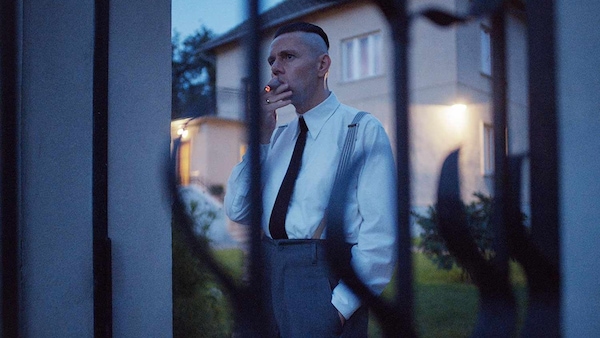
Last Updated: 07.15 PM, Mar 01, 2024
THE ZONE OF INTEREST is, by design, two films playing out side by side. There is the film we are shown and there is the film we are made to imagine. The former opens on a pastoral fantasy: a husband and wife picnic on a meadow by a river with their five children; they bask in the sun, splash around in the water and pick berries before driving home to their beautiful villa and their flourishing lives of birthdays, anniversaries and promotions. The latter takes shape in our mind’s eye through the sounds we hear: the scattered bursts of gunfire, the spine-chilling cries of agony, the huffs, hisses and howls of trains arriving are punctuated by a low thrum of industrial machinery.
Malice stains the air with a foul stench that gets under the skin. It is enough to make us feel sick in the stomach. As to the source, two and two can be put together once background details come into view. There is the smoke billowing from chimneys. There is the watchtower peeking from above barbed wire-crowned walls. And there is the blood being washed off a pair of boots. Next door to the beautiful villa is the Auschwitz concentration camp where a million people were killed during WWII. Picnicking and swimming and living it up is the family of the camp commandant Rudolf Höss (Christian Friedel) and his wife Hedwig (Sandra Hüller).
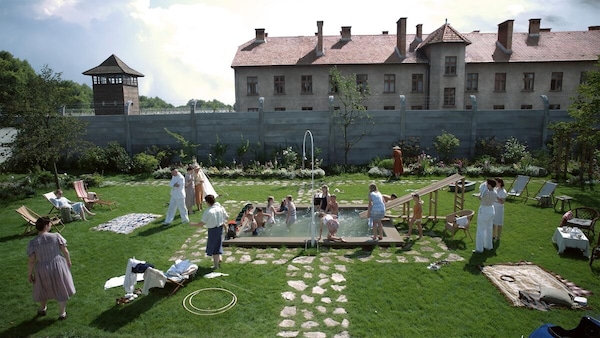
To call Glazer’s film an adaptation of the Martin Amis novel is an overstatement. The two share next to no resemblance beyond the title and setting. If Amis cast Höss as the fictional Paul Doll in his more grimly satirical book, Glazer de-fictionalises the character in his more austere depiction of the undepictable. The horrors of the Holocaust are invisible yet omnipresent in The Zone of Interest. The film dares to draw its power from what’s left out rather than put in, because Glazer recognises no film, no book, no story, no image can comprehend the gravity and lasting damage of such an atrocity. He trusts the audience has seen enough images — of men, women and children in striped uniforms, of shrunken bodies and shaved heads, of gas chambers and cremation furnaces — to not want to add to the desensitisation.
Implication may not be any less futile than explication. But in forcing us to hear what can’t be seen, he exploits our voyeuristic impulse of curiosity to challenge our tendency towards complacency. On trial is our own everyday adaptive mechanism to tune out news about mass death events — from pandemics and wars and genocides — like they were all background noise. Genocide isn’t a thing of the past. But we have become too comfortable in our denial to muster the imagination needed to reckon with such evil, even in the face of irrefutable evidence. As Glazer pushes us to engage with the film actively instead of passively, he allows us no escape from the quicksand of complacency, ushering in a paradigm shift in how films about genocide are made and seen.
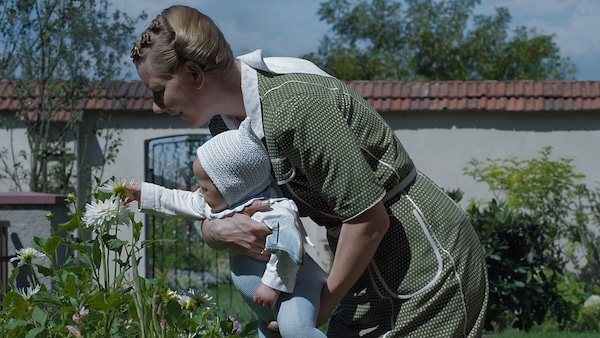
There is a quasi-documentary dimension to The Zone of Interest, same as there was to Glazer’s previous feature Under the Skin. Mostly filmed with hidden cameras, the film observes the domestic lives of the Höss family from a dispassionate remove. There are no close-ups honing in on the faces of actors playing monsters playing humans. The distance ensures we don’t risk empathising with the Hösses in any way. Instead, we are thrust into the role of bystanders watching the world’s most nauseating reality TV show — Keeping up with the Nazis. Glazer opens up a different perspective on the Holocaust by showing the day-to-day mechanics of mass murder and mass complacency.
Evil does not announce itself with talons and claws, but often takes the most ordinary form of diligent careerists like Rudolf, a rising star in the Nazi bureaucracy. Rudolf is a family man. He loves his wife, he takes his kids out for swimming and fishing, and he reads his daughter bedtime stories about Hansel and Gretel when she has trouble sleeping. Genocide, for him, is mere logistics — work that pays for his family’s luxuries. In his home office, he hears business proposals for more efficient methods of mass murder. Meanwhile, his wife Hedwig frets about her garden, entertains friends, and keeps her household staff of Polish locals on a tight leash. The children frolic in the pool. Grandma (Imogen Kogge) drops by for a while until the smoke of the neighbouring death machine proves too unfavourable to her respiratory health. The ordinariness of these domestic scenes curdles the blood.

Halfway through the film, marital tension erupts over a transfer. It turns out Rudolf has been so good at his job as a mass murderer he has been promoted to deputy inspector of all concentration camps, a job which requires him and the family to relocate to Oranienburg. A livid Hedwig refuses to uproot the family from their paradise in Auschwitz. “They’d have to drag me out of here,” she tells him. “This is our home. We’re living how we dreamed we would since we were 17. Beyond how we dreamed. Out of the city finally. Everything we want is on our doorstep.” Tunnel vision has never been more terrifying.
Keeping the victims off-screen as disembodied screams is not an act of erasure. Instead, their absence becomes a censure of their victimisers. For it was the Nazis who removed the Jewish people from their universe of moral obligation. What’s worse, the Hösses have no qualms about capitalising on their prisoners’ erasure. The ashes of genocide fertilise their garden. Hedwig tries on a fur coat and lipstick stolen from a Jewish prisoner. One of her friends reveals she found diamonds inside a tube of toothpaste and jokes about ordering more — as if she were making a purchase from Big Basket. Hedwig wasn’t oblivious to what Rudolf was up to on the other side of the wall; she knew perfectly well. In fact, turning people into ashes is such a prosaic topic in the Höss household it is used as a threat to keep servants in line.
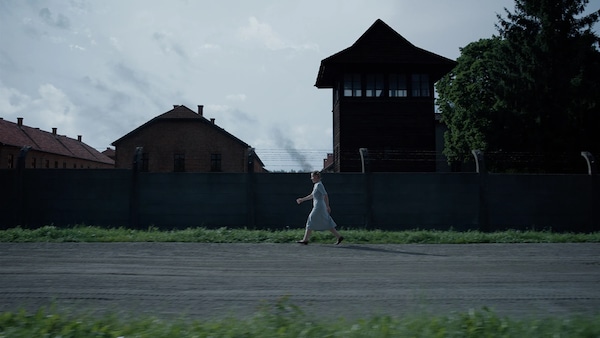
The Höss children are learning about the ways of their world too. At night, the oldest son Klaus (Johann Karthaus) isn't reading a book with his pocket torch in bed; he is counting his collection of gold teeth pried from the mouths of prisoners. On a fishing trip, ash and human remains float downstream, and Rudolf rushes to get his kids home to be scrubbed clean. Later on, the youngest son Hans (Luis Noah Witte) is playing with toy soldiers in his room when he hears his father order the drowning of a prisoner who was caught fighting over an apple. “Don’t do that again!” Hans mutters to himself — a scene that captures how a pernicious ideology gets passed down from one generation to the next.
This is a world where the cries of an infant and the barks of a dog can mean different things depending on which side of the wall the sounds are coming from. Where evil permeates the most routine domestic scenes, goodness can be found only outside the framework, in a negative alternate dimension. Twice in the film, we see a local Polish girl, rendered spectral by thermal imaging, sneak out at night to hide apples and pears in the worksites for the starving prisoners. At one of these sites, she discovers a piece of sheet music left in a tin by a prisoner. “Sunbeams, radiant and warm,” the subtitles transcribe the unsung lyrics as she plays the melody on a piano. “Human bodies, young and old. And who are imprisoned here, our hearts are yet not cold.” It is an elegy of unfreedom and resistance.
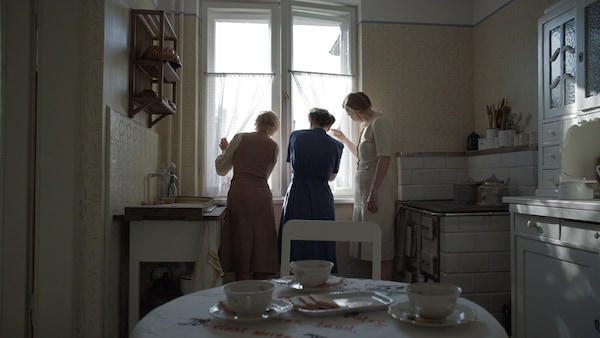
Rather than what we see, it is the music and sounds we hear that serve as powerful Jewish testimony in The Zone of Interest. Glazer opens his film with a pitch-black screen over Mica Levi’s atonal overture, preparing us for the moral abyss of the Nazi regime and the profound absence of the lives stolen. At the end, dissociating from the psychological toll of mechanised violence leaves Rudolf dry heaving, his body forcing him to acknowledge what his mind won’t. We see him pause and convulse again and again without purging anything. After all, evil cannot be purged from a system that is evil through and through. Not when conscience has been paralysed by choice for better productivity. As Rudolf stops and stares into the darkness of an empty corridor, the film cuts to present-day Auschwitz where the concentration camp is now a museum. Cleaners sweep the floors and vacuum the rooms lined with display cases of the shoes, luggage and uniforms of Holocaust victims — a flashforward that links the horrors of the past through the hallways of history to the present, warning us that complacency can wall us off from the horrors happening in our own backyard.
